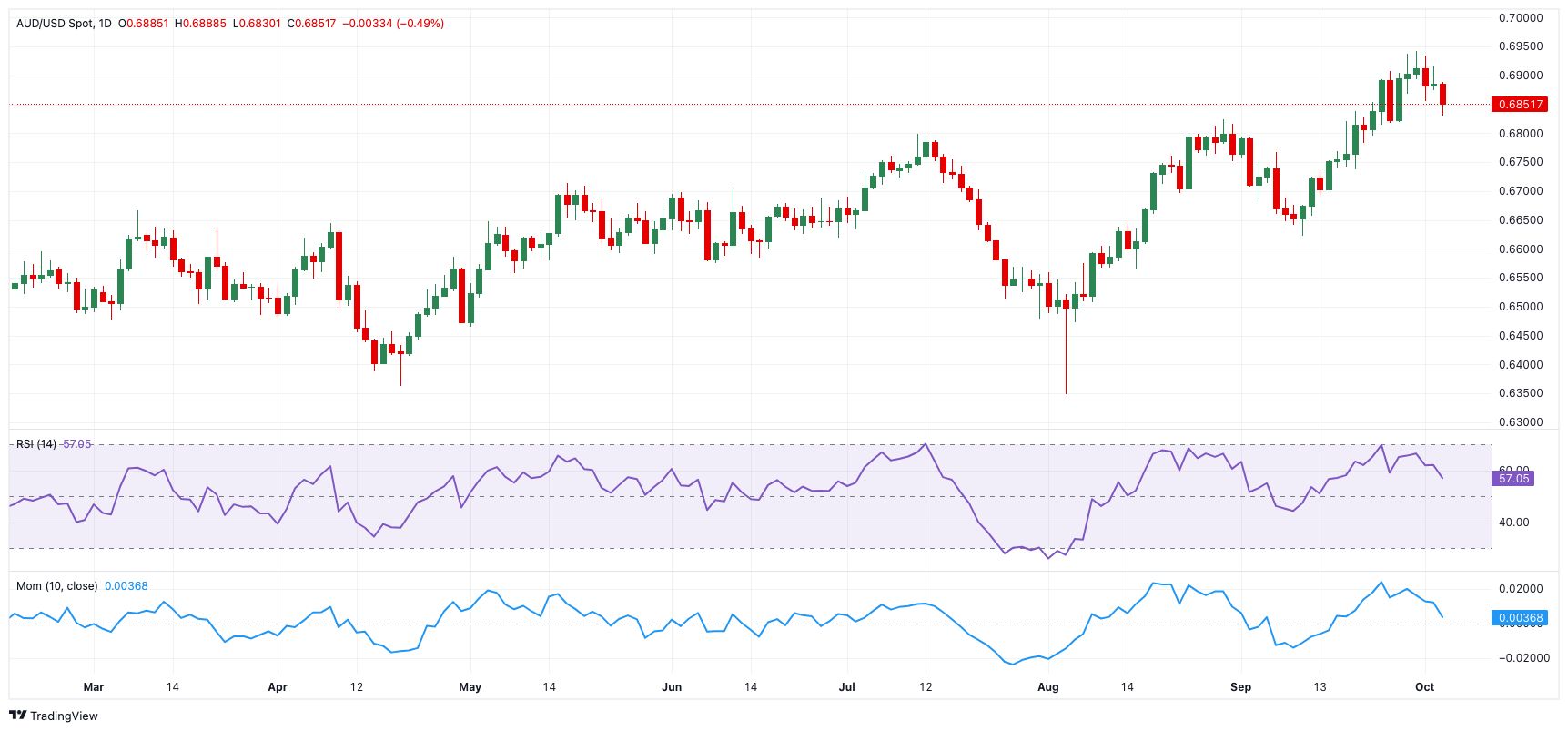- AUD/USD resumed its weekly downtrend and broke below 0.6900.
- The greenback maintained its bullish performance unchanged.
- Activity in Australia’s Services sector remained healthy in September.
AUD/USD saw its selling bias gather extra steam on Thursday. That said, the pair broke below the key 0.6900 support to hit new multi-day lows near 0.6830.
The renewed downward trend in the Aussie Dollar mirrored the performance of its risk-related peers, all against the backdrop of the intense recovery in the US Dollar (DXY), which remained propped up by auspicious results from data releases as well as geopolitical effervescence in the Middle East.
Collaborating with the sour sentiment around the commodity complex, copper prices resumed their weekly drop, while iron ore prices traded with humble losses, although keeping the upper end of the recent range. Furthermore, the recently announced stimulus measures in China, particularly those relating to its housing sector, should help iron ore prices keep their upside bias.
On the monetary front, the Reserve Bank of Australia (RBA) kept its rates unchanged at 4.35% during its September 24 meeting, as expected. While the RBA acknowledged inflation risks, Governor Michele Bullock signalled that a rate hike was not seriously considered.
Markets currently anticipate a 55% chance of a 25-basis-point rate cut by the end of the year.
In fact, the RBA is expected to be among the last of the G10 central banks to reduce rates, possibly cutting later this year to counter weak economic activity and cooling inflation pressures.
While Federal Reserve rate cuts are already factored in, AUD/USD could experience further gains in 2024, though concerns about China’s economic outlook and stimulus measures remain.
On the domestic calendar, the final Judo Bank Services PMI remained in the expansionary ground at 50.5 in September. It is worth noting that the index has been above 50 since March 2022.
AUD/USD short-term technical outlook
Extra losses could see AUD/USD drop to the interim 55-day and 100-day SMAs at 0.6699 and 0.6685, respectively, prior to the September low of 0.6622 (September 11), which is supported by the key 200-day SMA (0.6626).
On the upside, the initial barrier comes at the 2024 peak of 0.6942 (September 30) before the key 0.7000 hurdle.
The four-hour chart suggests some resurgence of the bearish trend. Having stated that, the initial support is 0.6915 ahead of 0.6942, and then 0.7024. On the downside, the initial support is 0.6829, followed by 0.6817. The RSI eased to nearly 40.
Information on these pages contains forward-looking statements that involve risks and uncertainties. Markets and instruments profiled on this page are for informational purposes only and should not in any way come across as a recommendation to buy or sell in these assets. You should do your own thorough research before making any investment decisions. FXStreet does not in any way guarantee that this information is free from mistakes, errors, or material misstatements. It also does not guarantee that this information is of a timely nature. Investing in Open Markets involves a great deal of risk, including the loss of all or a portion of your investment, as well as emotional distress. All risks, losses and costs associated with investing, including total loss of principal, are your responsibility. The views and opinions expressed in this article are those of the authors and do not necessarily reflect the official policy or position of FXStreet nor its advertisers. The author will not be held responsible for information that is found at the end of links posted on this page.
If not otherwise explicitly mentioned in the body of the article, at the time of writing, the author has no position in any stock mentioned in this article and no business relationship with any company mentioned. The author has not received compensation for writing this article, other than from FXStreet.
FXStreet and the author do not provide personalized recommendations. The author makes no representations as to the accuracy, completeness, or suitability of this information. FXStreet and the author will not be liable for any errors, omissions or any losses, injuries or damages arising from this information and its display or use. Errors and omissions excepted.
The author and FXStreet are not registered investment advisors and nothing in this article is intended to be investment advice.
Recommended Content
Editors’ Picks

Gold falls amid a possible de-escalation of US-China tensions Premium
Gold pulled back from its all-time high of $3,500 per troy ounce reached earlier on Tuesday, as a resurgent US Dollar and signs of easing tensions in the US–China trade dispute appeared to draw sellers back into the market.

EUR/USD retreats to daily lows near 1.1440
EUR/USD loses the grip and retreats to the 1.1440 zone as the Greenback’s rebound now gathers extra steam, particulalry after some positive headlines pointing to mitigating trade concerns on the US-China front on Tuesday.

GBP/USD deflates to weekly lows near 1.3350
GBP/USD loses further momentum and recedes to the 1.3350 zone on Tuesday, or two-day troughs, all in response to the frmer tone in the US Dollar and encouraging news from the US-China trade scenario.

3% of Bitcoin supply in control of firms with BTC on balance sheets: The good, bad and ugly
Bitcoin disappointed traders with lackluster performance in 2025, hitting the $100,000 milestone and consolidating under the milestone thereafter. Bitcoin rallied past $88,000 early on Monday, the dominant token eyes the $90,000 level.

Five fundamentals for the week: Traders confront the trade war, important surveys, key Fed speech Premium
Will the US strike a trade deal with Japan? That would be positive progress. However, recent developments are not that positive, and there's only one certainty: headlines will dominate markets. Fresh US economic data is also of interest.

The Best brokers to trade EUR/USD
SPONSORED Discover the top brokers for trading EUR/USD in 2025. Our list features brokers with competitive spreads, fast execution, and powerful platforms. Whether you're a beginner or an expert, find the right partner to navigate the dynamic Forex market.
